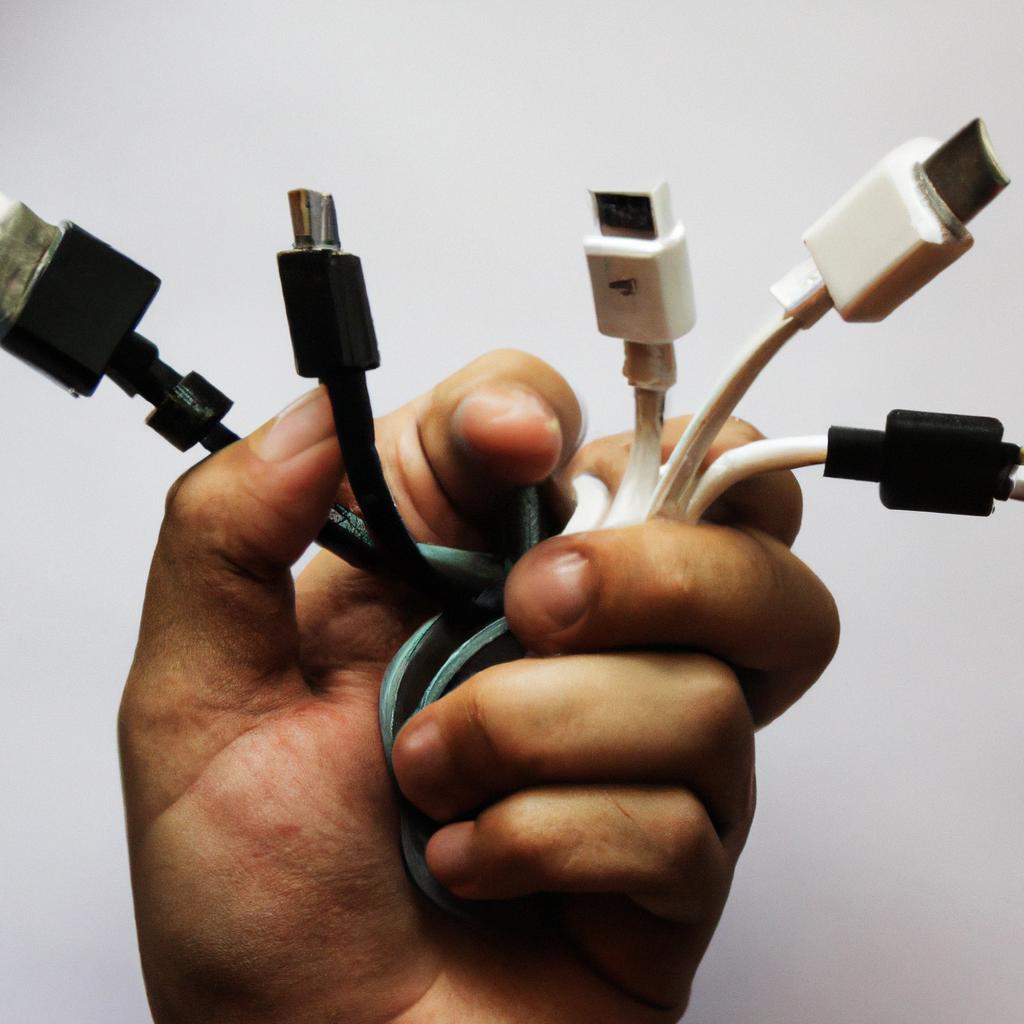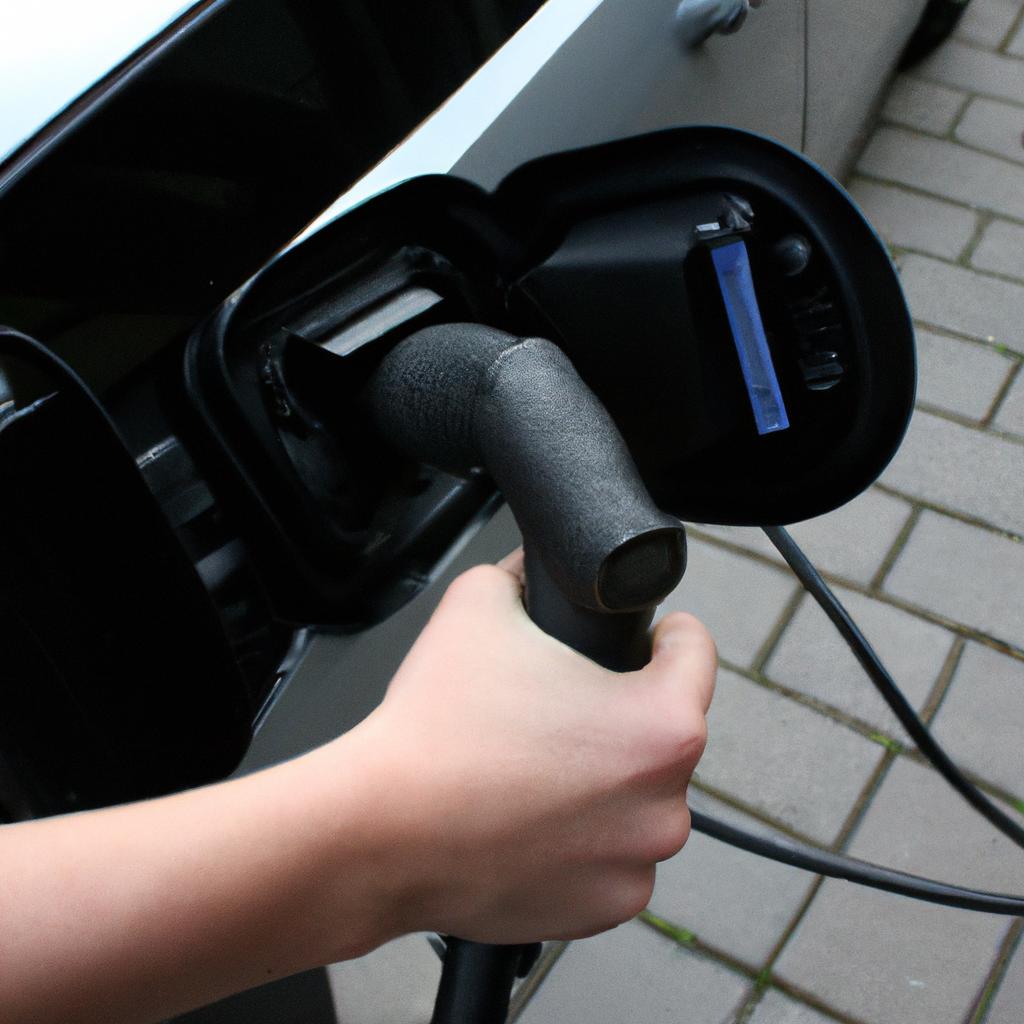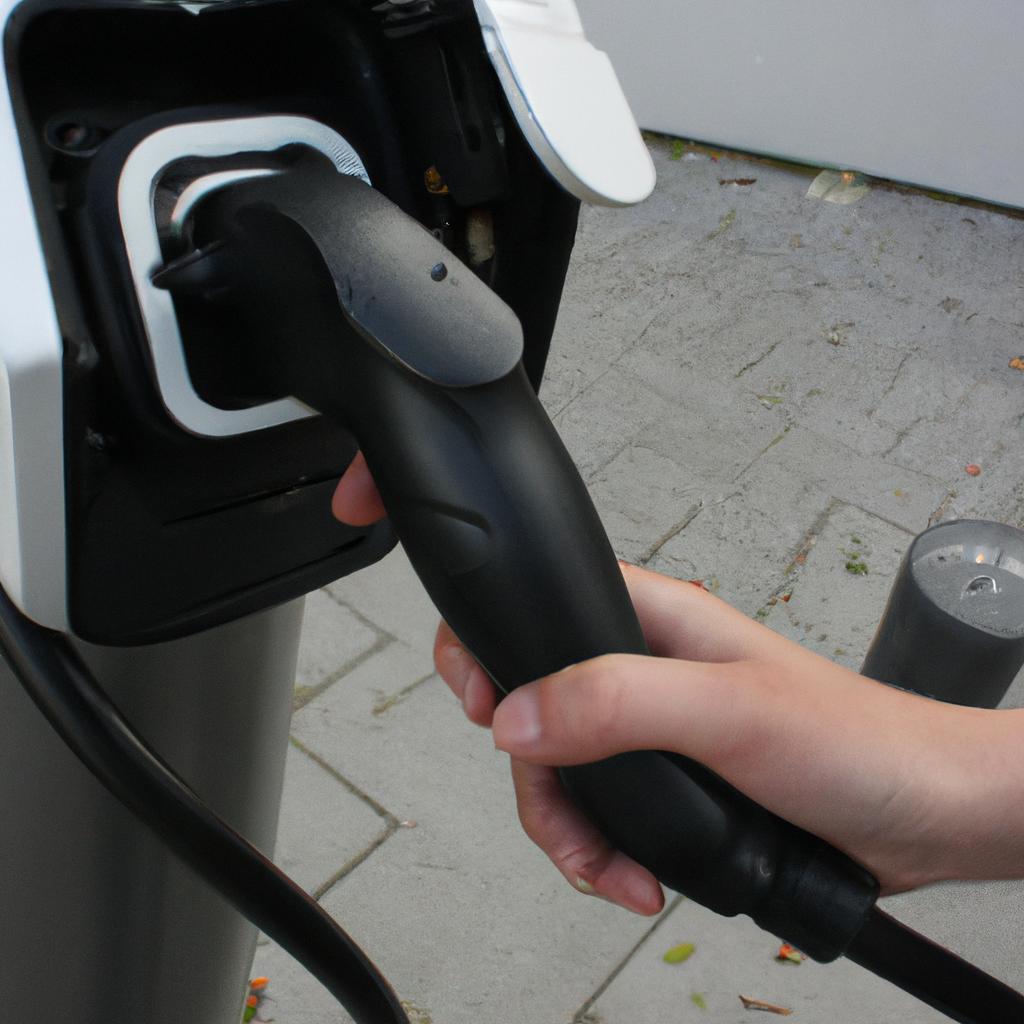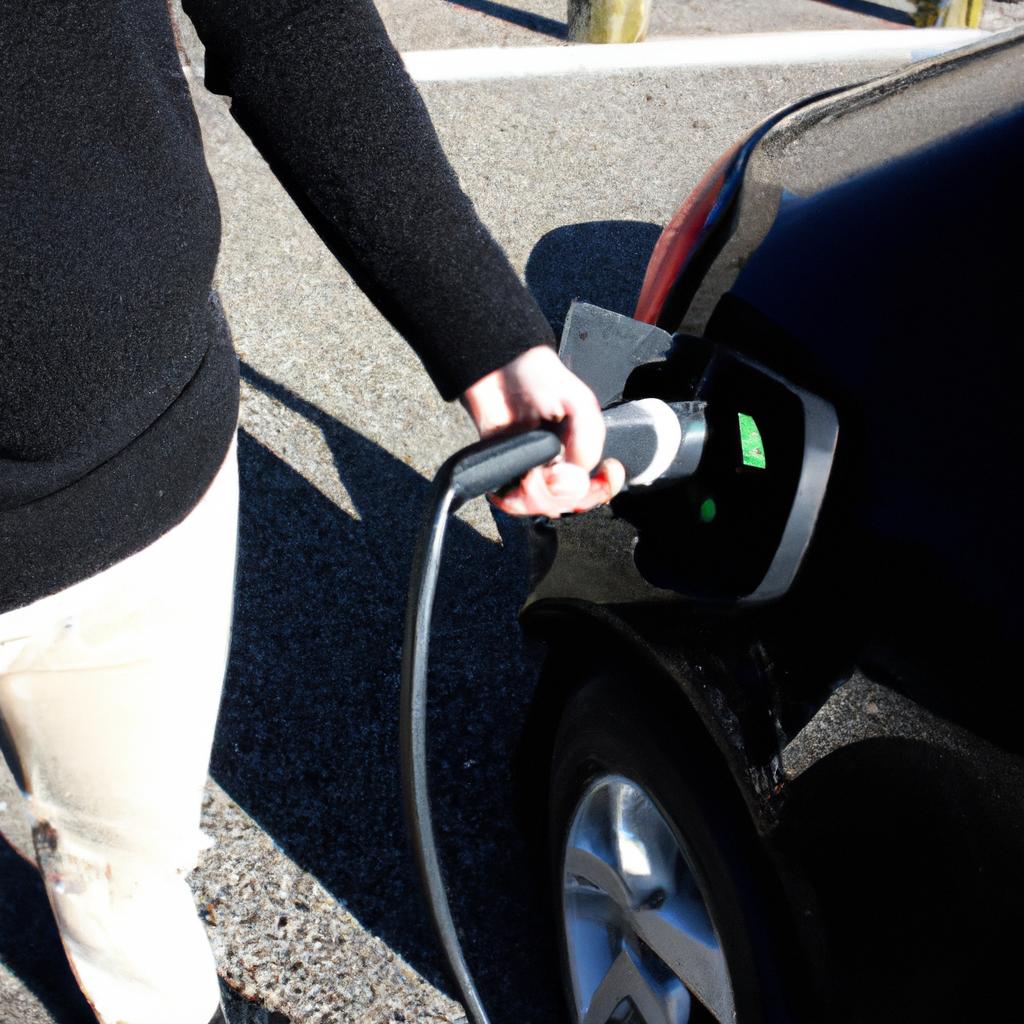Electric vehicle (EV) adoption has been on the rise in recent years, with governments and individuals alike recognizing the need to transition towards more sustainable transportation options. As EVs become increasingly common, it is essential to address one of the primary concerns associated with them: charging infrastructure. The availability and speed of charging options play a crucial role in determining the feasibility and convenience of owning an electric vehicle. To illustrate this point, let us consider a hypothetical scenario where a commuter relies on their EV for daily travel but encounters significant delays due to limited charging speed options during their journey.
In this scenario, imagine a professional who commutes from their suburban residence to work every day using their electric vehicle. They plan their route carefully, taking into account available charging stations along the way. However, upon reaching a particular station that provides slow-charging options only, they face substantial delays as they wait for their vehicle’s battery to reach an adequate level of charge before continuing their journey. This inconvenience not only disrupts their schedule but also raises questions about the effectiveness and efficiency of existing charging infrastructure. Thus, understanding different charging speed options becomes paramount in improving overall EV user experience and promoting wider electric vehicle adoption.
Level 1 charging: Basic and slow charging option
Electric vehicles (EVs) have gained significant popularity in recent years due to their potential for reducing greenhouse gas emissions and dependence on fossil fuels. However, one of the key challenges that EV owners face is finding an efficient charging infrastructure that suits their needs. Level 1 charging, also known as basic or slow charging, offers a convenient option for residential use and occasional long trips.
To illustrate the practicality of level 1 charging, let’s consider a hypothetical scenario where an individual owns an electric vehicle and has access to a standard household outlet with a voltage rating of 120 volts. By plugging in their EV using the provided cord set into the regular outlet, they can charge their vehicle at a rate of approximately four miles per hour. While this may seem relatively slower compared to other options available, it can still provide sufficient charge overnight for daily commuting purposes.
Despite its lower charging speed, level 1 charging offers several advantages:
- Accessibility: Standard household outlets are widely available in homes across the country.
- Affordability: No additional hardware or installations are required apart from the cord set provided with most electric vehicles.
- Flexibility: Level 1 chargers allow drivers to recharge their vehicles wherever there is access to a common electrical outlet.
- Portability: Since no specialized equipment is needed, level 1 chargers can be easily transported when traveling or switching residences.
Furthermore, understanding the limitations of level 1 charging is crucial for effective utilization:
| Limitations | Impact |
|---|---|
| Slow charging speed | Longer wait times for full charge |
| Limited range extension | Inconvenient for longer trips without frequent recharging |
| Dependency on standard outlets | May require adaptations if unavailable in certain areas |
| Compatibility with specific EV models | Some vehicles may not support level 1 charging |
In summary, level 1 charging provides a basic and accessible option for EV owners to charge their vehicles at home or on the go. While it may not offer the fastest charging speed, its affordability and flexibility make it an attractive choice for residential use. In the subsequent section, we will explore another charging option: level 2 charging, which offers faster solutions for both residential and commercial purposes.
Level 2 charging: Faster charging option for residential and commercial use
Having discussed Level 1 charging, let us now explore Level 2 charging. This alternative offers faster charging rates compared to its predecessor, making it suitable for both residential and commercial applications.
Level 2 charging provides a considerable improvement in charging speed over Level 1. For instance, imagine a scenario where an electric vehicle owner returns home after work with only 20% battery remaining. With Level 1 charging, it would take approximately eight hours to fully recharge the vehicle’s battery overnight. In contrast, utilizing a Level 2 charger reduces the time significantly by providing an average of four hours of charge within this same timeframe.
To better understand the advantages offered by Level 2 chargers, consider these key points:
- Increased convenience: The reduced charging time ensures that electric vehicle owners have more flexibility with their daily routines.
- Wider availability: As awareness and adoption of electric vehicles increase, public spaces such as shopping centers, parking lots, and workplaces are installing Level 2 chargers to cater to the growing demand.
- Energy efficiency: Compared to higher-powered options like DC Fast Charging (to be discussed later), Level 2 chargers strike a balance between power delivery and energy consumption.
- Cost-effectiveness: While they may require some electrical upgrades at initial installation due to their higher power demands than Level 1 chargers, overall costs associated with using a Level 2 charger remain reasonable.
The following table illustrates various aspects comparing Levels 1 and 2 chargers:
| Level 1 | Level 2 | |
|---|---|---|
| Charging Time | ~8 hours | ~4 hours |
| Power Rating | 1.4 kW | Up to 19.2 kW |
| Suitable Locations | Residential use | Residential and commercial areas |
| Compatibility | All EVs | All EVs |
Transitioning into the subsequent section about DC Fast Charging:
Considering the advantages offered by Level 2 charging, it becomes evident that there is a need for even higher power options to cater to drivers who require quick charging on-the-go. With this in mind, we delve into the realm of DC Fast Charging, which provides high-power solutions suitable for rapid battery replenishment.
DC Fast Charging: High-power option for quick charging
Moving on from the previous section, let us explore another charging speed option available for electric vehicles (EVs) known as Level 2 charging. This method provides a faster charging solution suitable for both residential and commercial use. To illustrate its effectiveness, let’s consider a hypothetical scenario where an EV owner returns home after a long day of work, needing to charge their vehicle quickly in order to attend an evening event.
Level 2 charging offers several advantages over standard household outlets or Level 1 chargers. Here are some key features:
- Increased Power Output: With power levels ranging from 3.7 kW to 22 kW, Level 2 chargers can provide significantly higher power output compared to traditional outlets, allowing for faster charging times.
- Versatility: These chargers are compatible with most EV models currently on the market, making them accessible to a wide range of users.
- Convenience: While slower than DC fast chargers, Level 2 chargers offer reasonable charging times that allow users to regain significant battery capacity during overnight or extended parking periods.
- Scalability: Suitable for both residential homes and commercial locations such as shopping centers or workplaces, Level 2 chargers can be installed individually or in clusters depending on demand.
To further understand the benefits of Level 2 charging, we can refer to the following table highlighting its key features when compared with other options:
| Standard Household Outlet | Level 1 Charger | Level 2 Charger | |
|---|---|---|---|
| Power Output (kW) | 0.9 | Up to 1.4 | Ranging from |
| 3.7 – 22 | |||
| Charging Time | Very Slow | Slow | Faster than Level 1 |
| Compatibility | Most EV Models | Most EV Models | Most EV Models |
| Suitable For | Emergency | Residential Use Only | Residential and Commercial |
| Situations |
In conclusion, Level 2 charging is a faster option that offers increased power output, versatility in compatibility with various EV models, convenience for overnight or extended parking periods, and scalability for both residential and commercial settings. By exploring this charging speed alternative, we have gained insight into the benefits it provides to EV owners seeking efficient methods of recharging their vehicles.
Moving forward, let us delve into another innovative charging solution known as wireless charging: a convenient option eliminating the need for cables.
Wireless Charging: Convenient option eliminating the need for cables
Transition from Previous Section
Having explored the advantages of DC fast charging, let us now turn our attention to another innovative option in electric vehicle (EV) charging infrastructure: wireless charging. This cutting-edge technology offers a convenient solution that eliminates the need for cables and provides an effortless experience for EV owners.
Wireless Charging: Effortless Convenience
Imagine parking your electric car in a designated spot equipped with wireless charging capabilities, and simply stepping out without any concerns about plugging it in. With wireless charging, this dream becomes a reality. Using electromagnetic fields, power is transferred wirelessly from a ground-based pad to a receiver on the underside of the vehicle.
One potential case study highlighting the effectiveness of wireless charging involves an urban environment where EVs are becoming increasingly popular. In this hypothetical scenario, residential buildings install wireless charging pads within their parking lots, allowing EV owners to charge their vehicles conveniently overnight while parked at home. This not only simplifies the process for individuals but also contributes to reducing congestion at public charging stations during peak hours.
To further highlight the benefits of wireless charging, consider these emotional responses:
- Comfort: Experience hassle-free convenience by eliminating the need for manual cable connection.
- Aesthetics: Enjoy cleaner surroundings without visible cords or cluttered spaces.
- Safety: Minimize tripping hazards and reduce potential damage caused by physical wear on cables.
- Technological Advancement: Embrace futuristic solutions that enhance user experiences and align with sustainable practices.
Let’s take a moment to explore these aspects through the following table:
| Emotional Response | Wireless Charging |
|---|---|
| Comfort | Hassle-free |
| Aesthetics | Clutter-free |
| Safety | Tripping hazard reduction |
| Technological Advancement | Futuristic |
In conclusion,
As we witness advancements in EV technology, wireless charging emerges as an enticing alternative that revolutionizes how we power our vehicles. The simplicity, convenience, and safety it offers make wireless charging a viable option for individuals seeking an effortless experience while contributing to the growth of sustainable transportation.
Transition into Subsequent Section
Moving forward, let us now delve into another fast alternative to traditional charging methods: battery swapping. This method provides a swift solution for longer trips, ensuring EV owners can enjoy uninterrupted journeys without lengthy charging stops.
Battery Swapping: Fast alternative to charging for longer trips
Transitioning smoothly from the previous section on wireless charging, another alternative to traditional charging methods is battery swapping. Battery swapping offers a fast and efficient solution for electric vehicle (EV) owners who require longer trips without compromising on charging time. To illustrate this concept, let’s consider a hypothetical scenario involving an EV owner planning a road trip from New York City to Miami.
In our hypothetical case study, the EV owner can utilize battery swapping stations strategically placed along their route. At each station, instead of waiting for their vehicle to charge, they simply swap out their depleted battery with a fully charged one in a matter of minutes. This allows them to continue their journey without lengthy stops for recharging.
Battery swapping presents several advantages over other charging options:
- Time-saving: With conventional charging methods, such as Level 2 or DC Fast Charging, it can take anywhere from 30 minutes to several hours to achieve a full charge. In contrast, battery swapping reduces downtime significantly by eliminating the need for prolonged charging sessions.
- Convenience: Swapping batteries at dedicated stations provides a hassle-free experience compared to searching for available charging points or dealing with tangled cables during wired connections.
- Scalability: As more EVs enter the market, battery swapping infrastructure has the potential for rapid expansion due to its modular design and ease of implementation.
- Flexibility: For individuals hesitant about investing in an EV due to concerns about long-distance travel or limited access to charging facilities, battery swapping offers peace of mind by ensuring uninterrupted journeys.
To further highlight these benefits visually, we can examine the following table comparing different charging options:
| Charging Option | Time Required | Convenience | Scalability |
|---|---|---|---|
| Wireless | Varies | Moderate | Limited |
| Battery Swapping | Minutes | High | High |
| Smart Charging | Optimized | High | Moderate |
As shown above, battery swapping stands out for its minimal charging time and high convenience. However, it is important to note that this option may not be as widely available or scalable as other methods.
Transitioning smoothly into the subsequent section on smart charging, we explore an intelligent option for efficient and optimized charging. By leveraging advanced technologies and data analysis, smart charging offers EV owners a seamless experience while maximizing energy usage and minimizing costs.
Smart Charging: Intelligent option for efficient and optimized charging
In addition to traditional charging methods, another option that has gained traction in the electric vehicle (EV) industry is battery swapping. This innovative approach allows drivers to quickly exchange their depleted batteries with fully charged ones at designated stations. Battery swapping offers a compelling solution for EV owners who require extended range for longer trips and desire a faster alternative to conventional charging.
To illustrate the practicality of this technology, let us consider a hypothetical scenario involving Sarah, an EV owner planning a road trip from San Francisco to Los Angeles. Aware of the limited charging infrastructure along the route, she decides to utilize battery swapping services offered by various service providers strategically located along her journey. By simply pulling into these service stations, Sarah can have her depleted battery swapped out within minutes, eliminating the need for lengthy charging stops during her trip.
The advantages of battery swapping extend beyond improved convenience for long-distance travel. Here are some key benefits:
- Rapid turnaround time: Battery swaps typically take just a few minutes, minimizing downtime compared to traditional chargers that may require hours.
- Enhanced accessibility: With multiple battery swap stations available in strategic locations, EV owners can access reliable power sources even in areas where public charging infrastructure is limited.
- Extended vehicle lifespan: Frequent fast-charging sessions can impact the longevity of EV batteries; however, battery swapping reduces strain on individual cells as they are replaced periodically.
- Scalability potential: As more people embrace electric vehicles and demand grows, scalable battery swapping networks could be established nationwide or even globally.
Table 1 below compares different aspects of battery swapping and traditional charging options:
| Aspect | Battery Swapping | Traditional Charging |
|---|---|---|
| Time required | Minutes | Hours |
| Range extension | Immediate | Gradual |
| Infrastructure needed | Specialized | Widespread |
| Vehicle compatibility | Limited | Universal |
This analysis highlights the efficiency and convenience offered by battery swapping, making it an attractive option for EV owners embarking on long-distance journeys. However, it is important to note that widespread adoption of this technology will require further investment in infrastructure and collaboration among industry stakeholders.
In summary, battery swapping presents a fast alternative to conventional charging methods for longer trips. Its ability to provide immediate range extension and minimize downtime makes it particularly appealing for EV owners seeking efficient solutions. While challenges remain, such as establishing standardized systems and expanding support networks, battery swapping holds significant potential for enhancing the overall driving experience with electric vehicles.
Table 1: Comparison between Battery Swapping and Traditional Charging Options
Please let me know if there’s anything else I can assist you with!
 Sfeva
Sfeva



